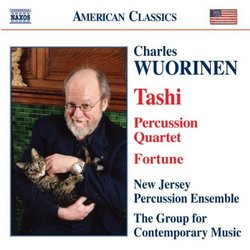| All Artists: Charles Wuorinen, New Jersey Percussion Ensemble, The Group for Contemporary Music Title: Charles Wuorinen: Tashi Members Wishing: 2 Total Copies: 0 Label: Naxos American Original Release Date: 1/1/2007 Re-Release Date: 6/26/2007 Genres: Special Interest, Classical Styles: Chamber Music, Historical Periods, Classical (c.1770-1830) Number of Discs: 1 SwapaCD Credits: 1 UPC: 636943932124 |
Search - Charles Wuorinen, New Jersey Percussion Ensemble, The Group for Contemporary Music :: Charles Wuorinen: Tashi
 | Charles Wuorinen, New Jersey Percussion Ensemble, The Group for Contemporary Music Charles Wuorinen: Tashi Genres: Special Interest, Classical
|
Larger Image |
CD Details |
CD ReviewsWourinen Chamber Music on Naxos Robin Friedman | Washington, D.C. United States | 05/15/2008 (5 out of 5 stars) "The American composer Charles Wuorinen (b. 1938) writes in a modernistic, largely atonal style, that manages to be both accessible and yet emotionally and intellectually difficult and demanding. Wuorinen has received both a MacArthur Fellowship and a Pulitzer Prize. His music is becoming readily available through releases of several CDs on Naxos as part of its American classics series. This series is proving to be a splendid way to get acquainted with Wuorinen's music.
This CD includes three works recorded in the 1990s. Two of the works were written for an ensemble consisting of clarinet, violin, cello, and piano while the third was written for a quartet consisting entirely of percussion. The former two works, titled "Tashi" and "Fortune" were composed for the contemporary music group known as Tashi which featured pianist Peter Serkin. They are performed here by an excellent contemporary ensemble called the Group for Contemporary Music. Tashi was composed in 1975. It is a dense, demanding, highly virtuosic work in five symmetrical movements. The first movement and the finale are rapidly paced and intense. The lengthy third movement, the work's centerpiece, is more flowing in character. The two even-numbered movements are both short and they develop in a more informal way the character of the movement they follow. The clarinet and the piano have prominent parts in Tashi as the clarinet sometimes trills and sometimes emits piercing tones in the upper reaches of its register. The piano writing is virtuosic and the music depends a great deal on counterpoint and on the interaction of the voices. The middle movement of the work is lyrical and slow but grows in intensity as it proceeds to work towards an elegaic ending. The finale features a wonderfully winding solo for the clarinet and a slow close with a final gasp from the clarinet. Wuorinen's "Fortune" was composed in 1979 for the same group of instruments as part of a Beethovenfest in Bonn. It consists of two movements, played without pause, titled "Before" and "After". The work, especially in its opening movement, captures some of the spirit of Beethoven in a modern idiom. It features repeated, clangorous chords which build tension and ultimately result in an accelerated tempo and an emotional climax at the end of the movement. The second movement is lighter in texture and faster until it too becomes more intense towards the end to close on a moment of drama with strong repeated notes, with a high harmonic passage for clarinet and violin. The third work on this CD is the unusual "Percussion Quartet" composed in 1994. This work is in two untitled movements with the second shorter and substantially faster than the first. The ensemble includes vibraphones, marimbas, tympani, tom-toms, bass drum, blocks, cymbals, and much more. I wa surprised at the flowing lines Wuorinen was able to create in this music punctuated, of course by strong rhythms. The opening movement features themes for the vibes and marimbas with strong rhythmic outbursts from the tympani -- including a long flamboyant solo in mid-movement. Wuorinen uses to the full the timbre of the percussion ensemble, contrastng the melodic character of the vibes with the beating of the drums and the bell-like passages near the conclusion. The second movement is a percussion dance in the form of a gigue featuring a light, moving theme in marimba and vibe with more large tympani solos mid-movement and towards the and. The work comes to a quiet close in the vibes. This is a fascinating piece for an unusual combination of instruments. It is far more than a novelty and it works musically. Hayes Biggs wrote the liner notes which are highly useful in helping to follow Wuorinen's music. Listeners with adventurous tastes and an interest in contemporary music will enjoy this recording. Robin Friedman " |

 Track Listings (9) - Disc #1
Track Listings (9) - Disc #1